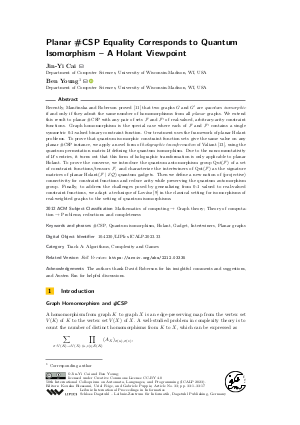Planar #CSP Equality Corresponds to Quantum Isomorphism - A Holant Viewpoint
Authors
Jin-Yi Cai,
Ben Young 
-
Part of:
Volume:
50th International Colloquium on Automata, Languages, and Programming (ICALP 2023)
Part of: Series: Leibniz International Proceedings in Informatics (LIPIcs)
Part of: Conference: International Colloquium on Automata, Languages, and Programming (ICALP) - License:
 Creative Commons Attribution 4.0 International license
Creative Commons Attribution 4.0 International license
- Publication Date: 2023-07-05
File

PDF
LIPIcs.ICALP.2023.33.pdf
- Filesize: 0.82 MB
- 17 pages
Document Identifiers
Related Versions
- Full Version https://arxiv.org/abs/2212.03335
Subject Classification
ACM Subject Classification
- Mathematics of computing → Graph theory
- Theory of computation → Problems, reductions and completeness
Keywords
- #CSP
- Quantum isomorphism
- Holant
- Gadget
- Intertwiners
- Planar graphs
Metrics
- Access Statistics
-
Total Accesses (updated on a weekly basis)
0Document
0Metadata
Abstract
Recently, Mančinska and Roberson proved [Mančinska and Roberson, 2020] that two graphs G and G' are quantum isomorphic if and only if they admit the same number of homomorphisms from all planar graphs. We extend this result to planar #CSP with any pair of sets ℱ and ℱ' of real-valued, arbitrary-arity constraint functions. Graph homomorphism is the special case where each of ℱ and ℱ' contains a single symmetric 0-1-valued binary constraint function. Our treatment uses the framework of planar Holant problems. To prove that quantum isomorphic constraint function sets give the same value on any planar #CSP instance, we apply a novel form of holographic transformation of Valiant [Valiant, 2008], using the quantum permutation matrix 𝒰 defining the quantum isomorphism. Due to the noncommutativity of 𝒰’s entries, it turns out that this form of holographic transformation is only applicable to planar Holant. To prove the converse, we introduce the quantum automorphism group Qut(ℱ) of a set of constraint functions/tensors ℱ, and characterize the intertwiners of Qut(ℱ) as the signature matrices of planar Holant(ℱ | EQ) quantum gadgets. Then we define a new notion of (projective) connectivity for constraint functions and reduce arity while preserving the quantum automorphism group. Finally, to address the challenges posed by generalizing from 0-1 valued to real-valued constraint functions, we adapt a technique of Lovász [László Lovász, 1967] in the classical setting for isomorphisms of real-weighted graphs to the setting of quantum isomorphisms.
Cite As Get BibTex
Jin-Yi Cai and Ben Young. Planar #CSP Equality Corresponds to Quantum Isomorphism - A Holant Viewpoint. In 50th International Colloquium on Automata, Languages, and Programming (ICALP 2023). Leibniz International Proceedings in Informatics (LIPIcs), Volume 261, pp. 33:1-33:17, Schloss Dagstuhl – Leibniz-Zentrum für Informatik (2023)
https://doi.org/10.4230/LIPIcs.ICALP.2023.33
BibTex
@InProceedings{cai_et_al:LIPIcs.ICALP.2023.33,
author = {Cai, Jin-Yi and Young, Ben},
title = {{Planar #CSP Equality Corresponds to Quantum Isomorphism - A Holant Viewpoint}},
booktitle = {50th International Colloquium on Automata, Languages, and Programming (ICALP 2023)},
pages = {33:1--33:17},
series = {Leibniz International Proceedings in Informatics (LIPIcs)},
ISBN = {978-3-95977-278-5},
ISSN = {1868-8969},
year = {2023},
volume = {261},
editor = {Etessami, Kousha and Feige, Uriel and Puppis, Gabriele},
publisher = {Schloss Dagstuhl -- Leibniz-Zentrum f{\"u}r Informatik},
address = {Dagstuhl, Germany},
URL = {https://drops.dagstuhl.de/entities/document/10.4230/LIPIcs.ICALP.2023.33},
URN = {urn:nbn:de:0030-drops-180851},
doi = {10.4230/LIPIcs.ICALP.2023.33},
annote = {Keywords: #CSP, Quantum isomorphism, Holant, Gadget, Intertwiners, Planar graphs}
}
Author Details
Acknowledgements
The authors thank David Roberson for his insightful comments and suggestions, and Austen Fan for helpful discussions.
References
-
Albert Atserias, Laura Mančinska, David E. Roberson, Robert Šámal, Simone Severini, and Antonios Varvitsiotis. Quantum and non-signalling graph isomorphisms. Journal of Combinatorial Theory, Series B, 136:289-328, 2019.

- Andrei A. Bulatov. The complexity of the counting constraint satisfaction problem. J. ACM, 60(5), October 2013. URL: https://doi.org/10.1145/2528400.
- Jin-Yi Cai and Xi Chen. Complexity Dichotomies for Counting Problems, volume 1. Cambridge University Press, 2017. URL: https://doi.org/10.1017/9781107477063.002.
- Jin-Yi Cai and Xi Chen. Complexity of counting csp with complex weights. J. ACM, 64(3), June 2017. URL: https://doi.org/10.1145/2822891.
- Jin-Yi Cai, Xi Chen, and Pinyan Lu. Nonnegative weighted #csp: An effective complexity dichotomy. SIAM J. Comput., 45(6):2177-2198, 2016. URL: https://doi.org/10.1137/15M1032314.
- Martin Dyer and David Richerby. An effective dichotomy for the counting constraint satisfaction problem. SIAM Journal on Computing, 42(3):1245-1274, 2013. URL: https://doi.org/10.1137/100811258.
-
Heng Guo and Tyson Williams. The complexity of planar boolean #csp with complex weights. Journal of Computer and System Sciences, 107:1-27, 2020.

-
László Lovász. Operations with structures. Acta Mathematica Hungarica, 18(3-4):321-328, 1967.

-
László Lovász. The rank of connection matrices and the dimension of graph algebras. European Journal of Combinatorics, 27(6):962-970, 2006.

- Martino Lupini, Laura Mančinska, and David Roberson. Nonlocal games and quantum permutation groups. Journal of Functional Analysis, 279, December 2017. URL: https://doi.org/10.1016/j.jfa.2020.108592.
- Laura Mančinska and David E. Roberson. Quantum isomorphism is equivalent to equality of homomorphism counts from planar graphs. In 2020 IEEE 61st Annual Symposium on Foundations of Computer Science (FOCS), pages 661-672, 2020. URL: https://doi.org/10.1109/FOCS46700.2020.00067.
-
David Roberson. Private communication, 2023.

-
Leslie G. Valiant. Holographic algorithms. SIAM Journal on Computing, 37(5):1565-1594, 2008.

- Shuzhou Wang. Quantum Symmetry Groups of Finite Spaces. Communications in Mathematical Physics, 195(1):195-211, July 1998. URL: https://doi.org/10.1007/s002200050385.
- S. L. Woronowicz. Compact matrix pseudogroups. Communications in Mathematical Physics, 111(4):613-665, December 1987. URL: https://doi.org/10.1007/BF01219077.
